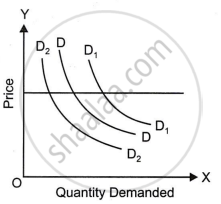Advertisements
Advertisements
प्रश्न
If X and Y are complementary goods, a rise in the price of Y will cause the demand curve of X to ______.
पर्याय
Shift to the left
Shift to the right
Extend
Contract
उत्तर
If X and Y are complementary goods, a rise in the price of Y will cause the demand curve of X to Shift to the left.
Explanation:
If X and Y are complementary goods, a rise in the price of Y will decrease the demand for Y, and consequently, the demand for X will also decrease because the two goods are used together. This decrease in demand for X will cause the demand curve of X to shift to the left.
APPEARS IN
संबंधित प्रश्न
When the demand curve of a product shifts to the right, it represents a situation of ______.
An increase in the price of electricity, will curve the demand for electric appliances to ______.
The goods whose demand decreases as income increases.
Match the following:
| Column I | Column II |
| A. Extension of demand. | (i) A larger quantity is demanded at the same price. |
| B. Contraction of demand. | (ii) A smaller quantity is demanded at the same price. |
| C. Increase in demand. | (iii) Fall in quantity demanded due to the rise in its price. |
| D. Decrease in demand | (iv) Rise in the quantity demanded of a commodity as a result of fall in the price. |
How does an increase in income affect the demand for a normal good?
What is decrease in demand?
Differentiate between a change in quantity demanded and a change in demand.
The following table shows a change in the demand. Read the table carefully and answer the question that follows:
| Case | Price (₹) | Quantity (kg) |
| I | 10 | 20 |
| 10 | 10 | |
| II | 10 | 20 |
| 5 | 20 |
What type of change is it - decrease in demand or contraction in demand? Give a reason.
There are train and bus services between New Delhi and Jaipur. Suppose, the train fare between the two cities comes down. How will this affect the demand curve for bus travel between the two cities?
Explain the diagram given alongside.

